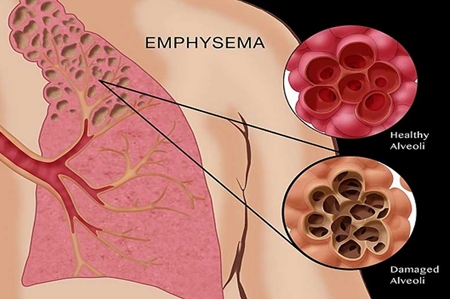
From the 1930s to the early 1980s, thousands of veterans of the United States military were unknowingly exposed to asbestos during their service. While all branches of the military used asbestos, the highest amount of the mineral used in the shipbuilding industry exposed countless Navy veterans who breathed in asbestos fibers every day without knowing the damage they could cause decades later.
The causal relationship between asbestos exposure and malignant and nonmalignant diseases has been established by various epidemiologic studies. Inhalation of air containing asbestos dust and fibers is the primary route of asbestos entry into the body. These small diameter fibers can travel deep into a person's lungs, where they may eventually lodge in the lung tissue causing several serious diseases.
Differentiating Between Emphysema and Asbestos-Related Diseases May Be Challenging
Emphysema is a chronic obstructive lung condition in which the overinflated and stretched alveoli don't allow the old air to escape, leaving no room for oxygen-rich air to enter.
Since the symptoms of emphysema are almost similar to those of common lung diseases, such as asthma, pneumonia, and tuberculosis, and often resemble the more severe ones, such as asbestosis or lung cancer, differentiating between emphysema and another illness is extremely challenging, even for medical experts.. Common signs and symptoms of emphysema and asbestos exposure:
- A cough that won't go away
- Chest tightness or pain
- Wheezing
- Frequent lung infections
- Reduced appetite/Weight loss
- Dyspnea (shortness of breath)
Many asbestos-related diseases are often diagnosed incorrectly, resulting in limited treatment options for patients. Asbestos-related diseases are complex, and most doctors easily misread the symptoms. This inaccuracy can delay the right diagnosis and treatment and also lead to recovering a smaller amount of money from asbestos trust funds than you are entitled to. Getting a second opinion outside the VA can certify an asbestos-related cancer diagnosis that gives you access to benefits and financial assistance. Likewise, if your emphysema develops into a malignant disease, you will have the entitlement to file for another asbestos claim for your new diagnosis.
Undergoing a simple chest X-ray, especially if there is a well-known history of asbestos exposure, is a very effective measure against the late diagnosis of a potential asbestos-related disease. CT scanning provides more detailed information than plain radiography about tumor characteristics and extent.
Asbestos Fibers Remain in the Lungs Forever After Inhalation, Posing a Constant Threat to Your Health
Veterans may be eligible to receive VA disability compensation if the emphysema develops into cancer and can prove that the malignant condition was caused by military service. Emphysema involves damage to the very fragile air sacs in the lungs. With this damage, the air sacs are restricted to oxygen. When veterans deal with emphysema, it becomes difficult to conduct daily activities.
To reduce your chances of being diagnosed inaccurately and treated inappropriately, we highly recommend you get yourself evaluated by a pulmonologist who specializes in asbestos-related diseases.
The disability level or rating of pulmonary disorders is often measured by the FEV1/FVC ratio, which represents the volume of air exhaled in the first second after full inspiration. Another test called "diffusion capacity of the lung" is a measure of how well oxygen and carbon dioxide are transferred between the lungs and the blood.
Conditions that mimic asbestos-related lung cancer:
- Emphysema
- Asthma
- Chronic bronchitis
- Pneumonia
Symptoms and Physical Findings Alone Are Not Sufficient to Diagnose Asbestos-Related Diseases
The physician must also establish the presence of pulmonary fibrosis by imaging and must determine whether asbestos exposure has occurred that is of sufficient duration, latency, and intensity to be causal. However, some asbestos-associated diseases, like asbestos-related pleural disease, can be seen with less intense exposure.
It is worth noting that the VA will determine your compensation amount based on the severity of your disease and how your condition is expected to progress. Getting a proper diagnosis from specialists, preferably specialized in asbestos-related diseases, like a B-reader, for example, is also essential for your prognosis and for receiving the correct treatment. A B-reader is a physician trained and certified by the National Institute for Occupational Safety and Health in asbestos-related lung X-rays. Typically, a B-reader evaluates chest X-rays to see if there are any changes or abnormalities that can be caused by inhalation of tiny particles of asbestos.
We are a nonprofit organization that helps veterans and military families understand the risk posed by exposure to asbestos. In this regard, we continue to provide accessible and detailed information, and we can put you in touch with some of the best legal experts if you want to file a claim for compensation after your cancer diagnosis.
